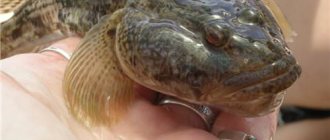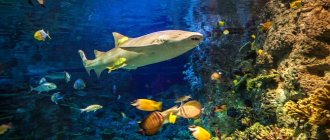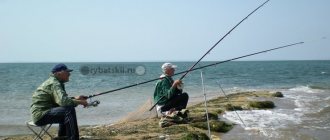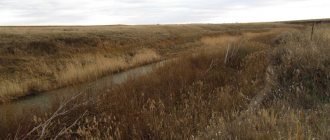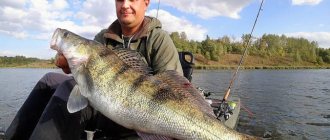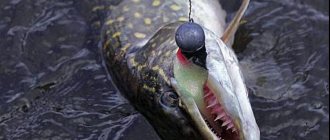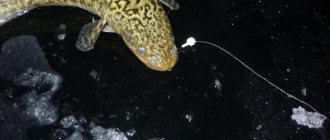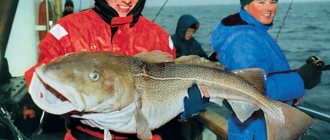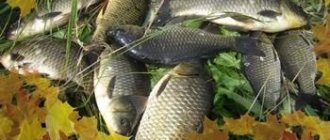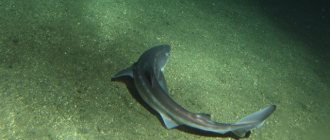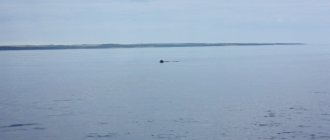Features of sea fishing
Sea fishing, unlike rivers and lakes, differs in conditions and fishing techniques. The population of fish is denser than in fresh water bodies, the current is always strong, with waves, and the water is clear, so the fish are always active, even in winter. It is better to fish in calm, calm weather, preferably in August. Many marine inhabitants are shy and when the wind increases, in order to avoid being thrown out to dangerous rocks by the current, they go deeper, to the bottom.
The fishing technique should be more intense, and casts should be far and correct to achieve better results. Fishing on the Black Sea from the shore is special:
- Possibility of using only hard rods and artificial baits.
- Lack of bite in the heat.
- Strong resistance when fishing for fish.
- A gregarious habit of individuals.
- Fishing mainly only for large fish.
Fishing in the Black Sea with any gear is most successful in August–September. If the weather is favorable, the fish are biting quite actively in October. In the heat of summer, catches are rare; the fish go deeper, closer to the bottom.
Croaker fish. How and what to catch croaker?
Croaker fish. How and what to catch croaker?
There are 2 species of croaker in the Black Sea. Black croakers are large fish with large bronze scales, they are up to 70 centimeters long; they are almost omnivorous predators. They attack any fish that swim up to their ambush between the stones - from a three-centimeter long silverside fry to a thirty-centimeter mackerel, they eat croakers and bottom invertebrates - crangon shrimp, stone crabs and grass crabs too. Schools of croaker can be found from ten meters and deeper, sometimes over a sandy bottom. But these are fish of underwater rocks, where underwater hunters look for croakers. The croaker spawns all summer in the coastal zone, and the eggs float to the surface of the water. In winter, croakers go into the sea far from the shore to great depths. In schools of croakers, sometimes you come across lighter fish on the lower jaw with antennae - this is the light croaker, one of the related species. Croakers are usually caught from the shore, despite the fact that croakers almost always stick to depths located a short distance from the shoreline. In the area of Novorossiysk and Anapa, I rarely saw it at a distance of 50-60 meters from the shore and at a depth of 8-10 meters (However, in the New World region in Crimea, I know a place where croakers stay much deeper). For some reason, it is less common to catch croakers from a boat, which is why the fisherman is required to be able to cast long distances and, when biting, to navigate the current situation. The fact is that, confidently grabbing the bait, the croaker often hooks itself, but it can immediately rush under a rock or stone and it is not always possible to pull it out from there. Croaker bite best at dusk. Use fresh shrimp for bait, dead or alive, it doesn’t matter. For the bottom: The main fishing line must be thick (0.6-0.7 mm) for the bottom, since it is necessary to fish in boulders and stones, where there are often snags. The equipment is quite primitive. Three or four leashes with a length of 10-15 cm and a cross-section of 0.3-0.4 mm with hooks No. 6-8 are tied at intervals of 25-30 cm to the main fishing line, starting from the sinker (100-120 g), which is located on the end of the tackle. When fishing among large stones, in some cases, in order for the fish to find the bait faster, the latter must be raised slightly. For this purpose, a float is placed on the fishing line near the leash. It can be made as follows: take a solid foam plastic of an oblong shape, make a hole in it, into which a tube made of non-stainless and oxidizing metal is tightly inserted. The smallest passage ring made of foam plastic is also tightly placed on the protruding end of the tube - then a leash will be attached to it. Of course, it is very important to choose the right fishing spot and make a good cast of the tackle. The rod must be stiff, fairly strong and long to ensure a good casting distance. The coil is also selected. Usually 2-3 such tackles are thrown and installed on special holder stands. When catching croakers on a donk, it is advisable not to deviate from the place for a long time, and in the dark, when fishing on a donk, it is advisable to supply them with bells. At the first strong pull, it is necessary to make a sharp hook and, without allowing the croaker to go into the stones, begin to quickly fish it out. On a fishing rod with a sliding float Modern gear allows the fisherman to cast at a distance of 50 meters or more. Long and fairly rigid carbon-plastic rods are best suited, equipped with a reel and guides (multiplier or non-inertial). For such fishing, light rods designed for “surf” fishing are also suitable; On these rods in most cases it is written: “surfcasting”. You can also use long two-handed spinning rods up to 4.5 m. The fishing line is wound in such a way that it is enough for a long cast and there is still a reserve of 15-20 m left. When testing fishing for a croaker, which, once hooked, always tries to go into cover, the leash and the main fishing line are chosen from those that are stronger (respectively - 0.3 mm and 0.25 mm). When fishing from a boat or from rocks, you should always try to immediately tear the fish off the bottom. A sliding float is put on the fishing line, in working condition, which is locked on top with a sliding knot or a small rubber cambric (Fig. 69), which regulates the depth, and when casting, with a lead pellet installed above the sliding sinker (40-50 g). Before reaching the hook from below (No. 7-9), the sinker is stopped with a second pellet. Next comes a hook with a leash. Casting is done in the same way as when fishing with a spinning rod. After casting, the bait and sinker fall to the bottom. A float on the surface, held by the cambric, signals a bite. In some cases, the emphasis on the line is not installed. In order for the float to rise, after lowering the weight and bait to the bottom, you only need to smoothly pull the line. The croaker sometimes stays under the edges, where the bottom is covered with an even layer of small pebbles. Such places can be found between Utrish and Anapa. It is much more effective to fish here with gear drifting under the influence of wind or current. In this case, the nozzle moves 10-20 cm above the bottom. For this type of fishing, a torpile sinker is used (a sinker with foam around the lead shell, which balances the gravity of the lead). The best place for catching croaker is considered to be the area of the Sudzhinskaya Lagoon, near Novorossiysk
Red mullet. How, where and what to catch red mullet?
https://vk.com/wall-1087481_32189 Scorpionfish, sea ruffe, sculpin goby, fishing methods? https://vk.com/wall-1087481_31003 Garfish, how to catch, bait for garfish? https://vk.com/wall-1087481_32370
https://vk.com/ohota_i_rybalka#post-23927120_3285
Places for successful fishing
You can fish at sea:
- From the shore, for both beginners and experienced fishermen, using any gear, even homemade ones. It is good to fish for large fish with a telescopic fishing rod 7-8 m long. Fishing is successful remotely and close to the shore. Almost any bait can be used. In stormy weather, from the shore with a strong wind, you need to cast the fishing rod as far as possible, at least 10 m. During the surf period, there is a high probability of catching large predatory individuals, so during a storm the release of worms and mollusks is huge, which is very tempting for fish
- From a cliff, but such fishing is quite extreme and is suitable only for professionals, people with skills in this matter. Fishing is successful using a telescopic rod with a sinker of at least 200 g from cliffs and rocky peaks.
- From the pier, in places near the beach. Catching medium-sized fish is suitable for beginners using spinning rods. Usually at the height of the season it is crowded, fishing is massive and widespread.
Fishing places
I think the most important guarantee of future successful fishing is the correctly chosen fishing spot. However, it is precisely this fact that is completely ignored by the few authors writing on the topic of sea fishing and fishing in the Black Sea in particular. Therefore, I propose to approach this issue very carefully and carefully, taking into account my experience and the experience of local amateur fishermen from Sochi and Abkhazia. The correct place for future fishing at sea is selected taking into account the feeding migration of the majority of fish, which from year to year visit their usual feeding areas at a strictly defined time of day. The constant presence of fish in the sea at their food base is influenced by both natural and specific factors.
It has been noted that the population of sea crucian carp in the Black Sea is little susceptible to such destructive factors as sea pollution by urban runoff, the disappearance or death of main food sources (destruction of mussels by the clam clam), disruption of the hydrological and hydrochemical balance. But coastal fishing with mid-depth trawls from small-tonnage seiners (500-1000 meters from the coastal edge) can cause the complete disappearance of some species of sea crucian carp and nullify the attempts of an amateur fisherman to catch at least one worthy specimen. And yet, excellent places for catching sea crucian carp exist! It is clear that these places are a secret of local amateur fishermen, who are extremely reluctant to share information with visitors - beginners who are eager for big sea trophies.
What areas and sections of the Caucasian coast from Tuapse to Sukhumi (Abkhazia) are the most attractive for sea fishing in the summer? Artificial ridges of concrete blocks and stones, piers, jetties, moorings, booms, ports, high rocky shores, breakwaters and the mouths of mountain rivers.
Artificial ridges of stones, concrete blocks, breakwaters
Colonies of mussels can be seen on the slope of the breakwater
Anyone who has at least once vacationed on a section of the Black Sea coast, from the village of Magri to Sukhumi, knows perfectly well that the railway in some sections comes close to the very edge of the sea, which is strewn with huge piles of concrete blocks and just boulders.
These protective structures were made back in the fifties and sixties of the last century to protect the railway from the destructive effects of waves. However, all these, at first glance, obscure and chaotic ridges of stones serve as an excellent place for spawning, foraging and protection from storms for numerous species of fish, which are quite easy to catch with a certain skill. The entire surface of these concrete blocks and boulders is inhabited by a huge number of different mollusks (mussels, oysters, rapana, tricoli), algae (zoster, cystosera, phyllophora), inhabited by sea fleas-tilitrids, idotes, and amphipods that are attractive to fish. The substrate located between the concrete and the mussel colony is inhabited by sea worms Nereis and sandworms. All these animal organisms are the main food source for most fish of the Sparov family (sea crucians). Almost 24 hours a day, standing on one of these concrete blocks and using bait taken right from under your feet, you can catch fish with a rigid rod, in any weather except a storm. Considering that vacationers rarely climb into these dangerous piles of half-submerged and slippery stones and blocks, a novice fisherman can take advantage of this truly wonderful place for sea fishing.
Breakwater as a fishing spot
It is also worth paying attention to the half-submerged concrete blocks 10-50 meters from the shore and running parallel to it, acting as breakwaters and reducing the destructive effect of the storm on the beach coastal strip. On these improvised breakwaters there are also colonies of mussels, thickets of eelgrass, phytomicrobenthos (fouling), which provide abundant food for blennies, greenfinches, and sea crucian carp and serve as a spawning ground for them throughout the summer. Typically, it is this type of breakwater that serves as the main place for effective fishing for local fishermen, where they fish for sea crucian carp, red mullet, garfish and all types of mullet at a depth of 2.5–4.5 meters.
Currently, there is convincing evidence that the artificial accumulation of stones in the coastal zone has a positive effect on the development of hydrobionts (invertebrates, algae, higher aquatic vegetation) and creates excellent conditions for the life of fish, so in some regions of the Mediterranean such structures are even specially erected .
River mouths
Border between river and sea
River mouths, that is, areas where fresh water meets sea water, are a special environment with a low salinity level, where marine fish such as mullet, silverside, sea crucian carp, gobies, red mullet, Black Sea salmon (euryhaline, capable of existing in reservoirs with different indicators of salinity), and freshwater: podust, chub and barbel.
Rivers bring here a large amount of various organic substances, which are the richest food supply for ichthyofauna. The bottom of the river at its border with the sea is covered with specific bottom sediments, the so-called detritus. This detritus (organic substances formed during the decomposition of inedible food, fish excrement, waste products of aquatic organisms) is the main type of food for all types of Black Sea mullet, which constantly enter river mouths in schools of 50-300 individuals, and serve as the main object of fishing for the local population .
As a rule, the area of the mouth of mountain rivers located on the section of the Caucasian coast from Magri to Adler (the rivers Mzymta, Kudepsta, Khosta, Sochi, Matsesta, etc.) has improved banks, reinforced on both sides with concrete slabs that regulate the flow of the river in case of flood or frequent autumn rains. It should be noted that fishing in the area of the river mouth on the border with the sea is extremely productive when fishing with bottom tackle. Although with this method, casting and fishing itself is carried out not in the river water area, but at a considerable distance from it (50-70 meters), which is associated with the daily feeding migration of fish such as white gar, beaked whale, wolffish, laskir, kantar, mormor, silver croaker, dark croaker, umbrina (corvina or striped croaker).
Considering the fact that when fishing, the fisherman does not need to go down from the shore (as in the first case under consideration), the option of fishing at the mouth of the river should be considered very convenient for a beginner. However, with all the positive aspects, this fishing option has one definite drawback - the absence in the immediate vicinity of attractive baits for sea fish, which can be obtained without any special problems (sandfish, nereis, mussels). In this case, you will have to go to a nearby pier or breakwater to stock up on promising bait (for example, mussels), and only then start fishing at the mouth of the river.
High rocky shores
Large semi-submerged boulders are an ideal place for catching large sea crucian carp using bottom tackle
On such shores, high rocky capes cut into the sea, sometimes hanging over the water (one can note a similar relief of the coastal strip in Dagomys, Khosta - Cape Vidny, Myusser - Abkhazia). Very often, the surface parts, subject to constant erosion by wind and sea water, have very steep slopes tens of meters high. At their base there are piled up stones, boulders and the already familiar concrete slabs that serve as breakwaters. In these rocky places it is quite deep and there are very favorable conditions for the life of bottom-dwelling fish species, such as croakers, sea foxes, sea dragons, soles, scorpion fish and burbots.
All these stone and concrete artificial formations are completely covered with periphyton (fouling), thickets of sea grass (Zostera) in the upper part and cystoseira in the lower part. Their bases are inhabited by huge colonies of mussels attached by byssal threads to a variety of substrates in which live sea worms (Arenicola marina) and annelid polychaete worms Nereis, which are the main food for most of the Sparov family and, among other things, a wonderful bait for fishing. Fishing from the shoreline, right at the edge of the shore, using a rigid rod or any bottom gear is extremely difficult and actually has little prospects. This is due to the extremely uneven bottom topography, all kinds of underwater ridges and huge thickets of cystoseira (large branched brown algae).
Fishing places
As a rule, local fishermen fish in such problem areas directly from the upper section of the rock, throwing bait (sand bait) using a 2.5-3 meter spinning rod (weight test sinker 50-100 grams), equipped with a light bottom option. Fishing begins from 17-20 pm, when croakers and very large specimens of sea crucian carp approach at a distance of 30-50 meters from the shore. In principle, if there are boulders or concrete slabs located near the shore, protruding half a meter from the water surface, you can try your luck using them using a float rod, after first looking at the bottom topography and measuring the depth for subsequent fishing.
It is worth noting a wonderful place - the village of Myussera (more precisely, a cape near the boarding house named after N. Lakoba), with a high rocky coast, literally teeming with large croakers and various types of sea crucian carp (captures of specimens over 1 kg are not uncommon!), located on the territory of sovereign Abkhazia, just south of Pitsunda. In this literal fishing paradise, you can also catch extremely rare specimens of large dentex (Dentex dentex), multitooth crucian carp (Spondyiosoma cantharus), white spars (Sparus pagrus), sea bream (Sparus aurata) - peculiar “guests” from the Mediterranean region, which They came to the Black Sea for fattening until the fall, so that they could then go back “home.”
Boarding houses and sanatoriums
Pier in Musser, from where you can catch large sea crucian carp
All of the options for fishing spots discussed above require the future amateur fisherman to constantly move along the coast, that is, spend a lot of time. However, not all categories of amateur fishermen can afford this. For example, fans of fishing who dream of its sea version, who come for a summer vacation to a boarding house or sanatorium, may naturally ask: “Where should we fish?” It is clear that people undergoing medical procedures, having lunch and dinner at strictly defined times, and on top of that, limited to a strip of sea of 50-100 meters, fenced off, have a hard time imagining the extraction of sea trophies that excite the imagination.
However, even on the beach of the most run-down boarding house, on the stretch from Magri to Sukhumi, there is still one single pier 5-15 meters long, from where sun-kissed white-bodied vacationers hang out from morning to evening. So wait for this long-awaited pause after 19 pm, when the majority of people inhabiting the boarding house run to dinner. And then you, with pre-prepared bait and bait, can safely take your place on the very edge of the only pier on the entire beach. Unfortunately, large catches are not expected, since the fish (sea crucian carp, greenfish, gobies, red mullet), frightened by the constant, noisy splashes, avoid this place. What to do? You can bring a spinning rod with you to the boarding house, equipped with two or three options for bottom tackle (more on this below) and, having found a colony of mussels in the lower underwater part of the pier, throw this nozzle 30-40 meters into the sea, hoping to catch sea crucian carp of 50-300 grams each . But with a 5-6 meter hard float rod you are unlikely to be able to catch anything valuable except the ubiquitous scorpionfish, gobies and small greenfinches. However, the blennies (Blennius sanguinolentus), which live in countless numbers in underwater meadows and are completely unsuitable for food, will give you a chance to hone your fishing skills in the first fishing season at sea.
Good advice! If you find large colonies of mussels on the pier or a nearby breakwater, collect them on the first day of your stay in the boarding house in a plastic bag in the amount of 3-6 kg, bring them to the pier, take a cobblestone and break every single piece into a cake. Then carefully collect this mass with your hands (the edges of the mussels are sharp, you can cut yourself) and leave them at the intended fishing location. The familiar smell at the bottom of the sea, the main source of food for greenfinches and sea crucians - mollusks, in 15-30 minutes will attract a sufficient amount of small fish to this place. And further. Very often, on the beaches of boarding houses and sanatoriums, from the pier, parallel to the shore, breakwaters extend in both directions in the form of rectangular concrete slabs lying on the bottom and sunk 15 - 50 cm from the surface of the sea. Explore the pier area. If such structures exist, then your chances of catching fish increase dramatically. Standing with your feet on the concrete slab of the breakwater in calm weather, without disturbing anyone, you can fish from morning to late evening, both with a rigid rod and with a bottom. How to do this with a minimum of convenience will be described below.
What kind of fish is found in the Black Sea?
This area is home to almost 180 species of fish. Often caught by fishermen:
- Ruffs.
- Flounder.
- Mullet.
- Gobies.
- Sea bass.
- Red mullets.
- Horse mackerel.
- Sprat.
- Herring.
- Acne.
- Anchovy.
In summer it occurs:
- Tuna.
- Pelamida.
- Mackerel.
- Rarely, but you come across sultanas.
- Beluga.
- Sargans.
- Gorbyl.
- Dark.
There is an abundance of fish of different sizes in the Black Sea. Gobies are popular and are a delicacy for many. To attract their attention, it is better to place the bait at the very bottom. There are a lot of mullet in the sea near the shore, singili, a medium-sized fish with an orange spot on the cover of the gills.
Fishing in the Crimea, closer to the Caucasus, is successful for small horse mackerel. Quite large individuals are found not far from Georgia and Abkhazia. Horse mackerel often recklessly searches for prey, literally jumping out of the water. If you find yourself at sea at such a moment, catching horse mackerel will not be difficult.
Catching sea crucian carp with a fishing rod is successful in the waters of the Black Sea; shrimp will be used for bait. Beautiful bright wrasses are found in the coastal zone closer to rocks and stones overgrown with algae. The wrasse fits on almost any tackle. There are a lot of perches in the sea; anglers love to catch this type of fish.
There are, of course, a lot of crabs, shrimps, and mussels of various sizes in the sea. But poisonous fish can also be caught on a hook: dragonets, sea ruffes, which are similar in appearance to other species. You need to be careful. If the fish is unfamiliar to you, it is better to release it back to avoid poisoning.
Sea fishing accessories
In addition to the gear described above, sea fishing uses hooks, landing nets, catching loops for very large fish, cages, cooers, yawners, extractors, detachments, depth gauges, feeders, stands for rods, lights for night fishing, containers for baits and baits, cases for fishing rods and other accessories and devices that are almost no different from those intended for fishing in inland fresh water bodies. You should dwell in more detail on marine echo sounders and small vessels.
Marine echo sounders
For lovers of fishing from the shore, American and other companies produce coastal echo sounders capable of translucent water thickness to 30–50 m with horizontal beams. Echo sounders differ in the number of functions they perform: the most “advanced” ones use a sound signal to warn of dangerous depths, large objects, underwater reefs and etc.
Small vessels
They use wave-resistant boats, large boats and even small ships. For example, on the Black Sea, during the period of active fishing for horse mackerel or other schooling fish, voyages on passenger pleasure boats are organized especially for fishermen.
At the final stage of fishing, when the shark begins to walk in circles, it’s a good idea to have an assistant who, when lifting the shark on board, will help unhook the sinker and pick up the fish.
Sea float rod
Sea float rod
Catching sea fish with a float rod
Red mullet or red mullet.
A fixed float has good sensitivity and light weight, but it can easily break off, rotates at a depth equal to the length of the rod and is of little use if the depth does not match the length of the rod.
The best bait for red mullet is the nereid, a red-green sea worm. A piece of worm should be placed on the hook. With a good bite, the red mullet will also take an ordinary earthworm or dungworm, which is also planted not entirely, but in small pieces. Sometimes red mullet pecks on a piece of raw shrimp meat and sea fleas.
Scorpionfish (sea ruff).
It is caught from the shore or structures protruding far into the water, at shallow depths with a rocky bottom covered with brown algae. It is well fished from a boat using onboard float rods at depths of up to 30 m.
Tips for fisherman: Echo sounder for deep sea fishing - What to choose for fishing
Lavrak.
The effectiveness of fishing is increased by bait placed in a bag with small cells, from where food particles will be washed out even with a slight movement of water. The feeder is held at the bottom by a weight. For bait, crumbles of finely chopped fish, shrimp, crab meat, fish marc, etc. are suitable. Scented extracts are also used to serve as additional bait.
Mullet.
Various types of mullet can be caught well using a float rod. It is better to fish from the shore in the early morning, when schools of mullet in search of food sometimes follow near the very edge of the water. When fishing with a fishing rod with a blind rig, it is imperative to camouflage yourself behind cover. This could be some kind of coastal structure or a large boulder. Good places are port berths, hulls of ships, boats, small yachts, where you can remain unnoticed.
Usually, when fishing for mullet, they use tackle designed for long-distance casting. Mullet is a very cautious fish, and catching it requires the finest tackle. Even for catching large specimens (about 1 kg), they often take fishing line with a diameter of 0.1-0.12 mm, because Mullet sees well in clear water. In places where the water is somewhat cloudy, you can use a fishing line with a larger diameter (0.25 mm). The nozzle is placed approximately 10-15 cm from the bottom. In ports, mullet often feed at mid-water, so the descent should be appropriate.
The mullet bite is sharp, sometimes the float immediately goes under the water, and sometimes it jumps. A fishing rod left unattended can be jerked sharply and carried out to sea.
Laskir.
Sea crucian carp are caught both from the shore and from a boat. The fishing rod rig should be thin (line -0.14-0.15 mm, leash - 0.1-0.12 mm) with a sensitive (1-2 g) float. The bait is a piece of shrimp, sea worm or mussel meat.
Goby.
Wrasse or Zelenukha.
Horse mackerel.
Shemaya.
It is caught in the upper layers of water with a fishing rod designed for long-distance casting, equipped with a self-loading float. The main line is 0.2-0.25 mm, the leader line is 0.12-0.18 mm. The bait used is insects, crayfish meat, mussels, shrimp, and sea worm. It likes to feed on extensive shallows, so the bait must be cast at a distance of up to 20 m from the shore. Good places for fishing are where small rivers flow into the sea.
Gorbyl.
Garfish.
In addition, the fishing rod can be equipped with a float with a built-in sinker, which makes it easy to make long casts when fishing from above. A rigging option is also possible when a weighted float is tied to the end of the fishing line, and the leash is located a meter away from it (Fig. 3).
The best bait everywhere is shrimp meat. The Baltic garfish also really likes a strip of freshly caught herring meat. If the bite is sluggish, the hook must be done with a long pause, when the bait is in the corner of the fish’s mouth.
The most productive fishing is in early spring, when small flocks of garfish walk near the shore. Walking fishing: moving along the surf, you periodically repeat casts.
Sea pike perch.
Sometimes it is caught with live bait float rods at depths of 6-10 m. At greater depths it is caught from a boat using an onboard fishing rod. The lead line must have a diameter of at least 0.4 mm. Hooks are nickel-plated or tinned, long-shanked, No. 8-10. Small fish (anchovy, sprat, red mullet, etc.) are used for bait. Good places for fishing are located near the mouths of rivers flowing into the sea, in areas with dense clay soil.
mackerel
Fished with float rods throughout the day. The best bite happens in the morning. You can fish from a boat, coastal rocks, piers, piers and breakwaters, at a depth of 3-10 m. The bait is small fish or pieces of fish. In the Black Sea it appears in the Kerch Strait area in May-June. The equipment is the same as for catching garfish.
polar shark
The sharp sound of a rattle notifies that a bite has occurred. After it becomes monotonous, you should make a fairly powerful hook. The shark’s first jerks are the strongest—they try to restrain them by forcefully releasing the line. Having taken about 100 meters of fishing line, the shark most often stops. This is where you should start fishing.
The best bait is considered to be live herring, and the tail fin should be cut off so that the bait looks helpless, in addition, this prevents excessive twisting of the line (Fig. 4).
Drift fishing often occurs at very great depths with strong currents, so quick-release sinkers weighing from 100 g to 1 kg are used. Take a leash that is soft, but reliably protects against rubbing with teeth, such as “Steel Silk”. In principle, it is permissible to use leashes made of steel wire. For the largest specimens, a hook No. 18/10 (international classification) is required.
At the final stage of fishing, when the shark begins to walk in circles, it’s a good idea to have an assistant who, when lifting the shark on board, will help unhook the sinker and pick up the fish.
sea fox
Places where you can catch sea fox are found everywhere from Taman to Sochi. In Crimea, many stingrays live in the area of Sudak and the New World. There are places here where there are great depths not far from the shore. The best time to catch sea fox on the Black Sea coast and in Crimea is August and September.
"Russian Hunting Newspaper No. 43.44 - 2002"
Attention!
Kaliningrad Fishing Club” was used as source material
«
Fishing time determines tactics. When fishing light-colored, as a rule, fish with a small mouth bite, so the bait should be small: a worm, a 1.5-inch twister, a small slug. Micro-oscillators, retractable leash, micro-jig, bombards, split-shot and Texas rig with a small hook size are used.
For bottom fishing, I would recommend starting with cranks, a drop shot, a microjig and a retractable leader. For pelagic fishing - microjig, small minnow wobblers, micro-oscillators with silicone twisters, and even better, worms.
Bites often follow the wiring repeatedly. From strong blows like “give back the spinning rod” to light pinching of baits. If there are unconvincing bites, stop the wiring and pause. You can make a slight tremor with the tip of the spinning rod without loosening the tension of the braid. Scorpionfish very often catch up with bait that suits their taste.
Fishing from the shore
Fishing from the shore
First appearing in England, LIDGERING
first conquered freshwater fishing, and then took one of the first places among fishing methods in the sea waters of the Mediterranean countries.
As often happens in the world of sport fishing, it was athletes who spread this method, which can be considered as a development of classic bottom fishing using specially designed gear and accessories. The most important feature of liggering
is the use of feeders.
In fact, sea fishing is significantly different from freshwater fishing. Most often, completely different fish are caught in the sea, which also have their own characteristics, their own feeding preferences.
Every season Odessa is visited by a huge number of tourists from Ukraine and Russia. Of these, a considerable proportion are also fishing enthusiasts, whether they are professional fishermen or ordinary people who like to sit on the shore with a fishing rod. In fact, sea fishing is significantly different from freshwater fishing. Most often, completely different fish are caught in the sea, which also have their own characteristics, their own feeding preferences.
Groundbait and bait
The baits also differ - at sea they are almost never caught with baits of plant origin: bread, pearl barley, corn, hominy, peas, etc., since the vast majority of sea fish are predators.
Tips for fisherman: Spinning rod for sea cod fishing - Features of choice
Groundbait is used very rarely. Most often it is small fish ground in a meat grinder, as well as crushed mussels or other shellfish.
Usually, if the goal is to feed a goby when fishing from a pier, then I crush the mussels with a stone, grind them into small pieces and throw them into the fishing area in small portions. This works best when the bite is weak in cool water, when the gobies sit in holes and it is difficult to lure them out of there.
Ground fish is used for catching bottom fish. If you place it in a special metal feeder (the currently popular metal fish tank can be used) and lower it vertically to the bottom, for example, from a boat or boat, then the food will be quietly washed out by the underwater current and attract fish.
Shellfish meat (most often mussels) - almost all coastal stones, underwater parts of piers, and breakwaters are covered with mussels. In the summer, when the water is warm, stocking up on mussels for fishing is not difficult. I take a snorkeling mask with me and dive into the water, and then pick shells off the rocks.
I clean the mussels either with a penknife, splitting the shells in half, or I break the shell with a stone and take out the meat. Mussel is a favorite dish of the most popular sea fish in Odessa - goby, although neither flounder, nor whiting, nor horse mackerel will neglect it. In addition to mussel meat, you can also use rapan meat, which is tougher, but will also work if the bite is active.
Shrimp (or as they are called in Odessa - crustaceans) . In the warm season, it is not difficult to get this bait and even a child can do it - just walk with a net through shallow water and hold it underwater in the area of large stones or the pier wall. Shrimp can also be caught with a spider (spider) by lowering it vertically from the pier and lifting it close to the wall.
If you don’t have the time or opportunity to catch shrimp, you can buy them at the market or in a store. Local fresh seafood is best suited - at the famous Odessa Privoz. You can also use frozen ocean fish, which are available in abundance in supermarkets, but the bite will be worse.
Most often, a goby is caught using shrimp. Fresh, boiled shrimp, which are littered with the counters of many coastal trays in the summer, work best; they are not suitable, although in the complete absence of other baits they can be used.
There are several ways to place a shrimp on a hook: whole, without the head, or by first peeling off the skin and tearing off the head. The last method is a little labor-intensive, but with a weak bite it gives an excellent result. Gobies are most often caught with shrimp, but whiting, horse mackerel, flounder and other fish will not pass by.
The sea worm (Nereis) is perhaps the most versatile bait in sea fishing; almost all types of fish are caught with it. However, getting Nereis is not so easy. It lives in the coastal soil of the sea or some estuaries at shallow depths, but not everywhere. You need to dig it with a shovel, removing the worms from the soil. At Privoz it is sold in boxes. For full fishing, I usually take 2-3 boxes of worms.
This is bait that spoils very quickly in the heat, and it cannot be stored for a long time. Nereis is the only bait that sea mullet bite in Odessa, as well as one of the favorite delicacies of kalkan and glossa.
Small fish. Typically, Odessa fishermen use ferine (siberian), which can be caught with a small fish directly from the pier or pier, as well as with a miniature tyrant or a float rod. When fishing for garfish, I use live ferina, and when fishing for flounder, goby or whiting, I use whole or pieces of fresh or salted ferina.
I mainly use squid meat Frozen squid can be bought in almost any supermarket or market. I cut it into small pieces and put it on the hook. Squid is a hard bait that, with an active bite, will not often come off the hook.
This is not the entire list of baits that you can use to catch fish in the sea. Some fish can be caught using crab meat, dung worms, etc. I think you shouldn’t worry about bait before leaving for the resort; everything you need can be obtained or bought on the spot.
Tackle
Tackle for sea fishing should also differ from its freshwater counterparts primarily in security and durability. Sea salt water causes much more corrosion of metal than fresh water. Therefore, rod rings, reel components, hooks, carabiners, etc. must be made of stainless materials.
This is not a necessary condition, but extremely desirable, since the service life of the gear can be significantly reduced. I have had cases where cheap Chinese reels lasted no more than 1 season and were almost completely destroyed at sea.
The quality and protection from sea water of the hooks is crucial, since they can be dulled during one fishing trip on the rocks, and they can also simply rust. Modern manufacturers of hooks have series designed specifically for fishing in salt water (labeled “salt water”), and you need to pay attention to them.
The fishing line also has certain requirements. It must be resistant to abrasion from stones, piers, etc. Nowadays, you can find on sale a large selection of specialized fishing lines that have such properties due to several protective layers. And the more such layers, the better, naturally.
Of course, you can also use regular freshwater fishing line. I have tried many different options and found that some models develop a white coating of salt that, when dried, stains the reel spool. In addition, after 1–2 months of use, when fishing from piers or the shore, the fishing line wears out and loses its strength in these places. The fishing line has to be changed at least once a season, or even more often.
Another feature when catching sea fish is that they are not so picky about the thickness of the fishing line. Of course, there is some relationship, but still not as significant as when fishing in fresh water.
Hooks are a common occurrence when fishing from piers, since the bottom here is strewn with stones in many places, and the goby most often stays in them. Therefore, the supply of hooks and sinkers you take with you on a fishing trip should be sufficient.
It is best to take with you on a trip a compact telescopic rod 2.7–3.5 m with a spinning reel equipped with a 0.3–0.4 mm fishing line. Several floats with a carrying capacity of 10–15 g, a set of sinkers of various weights, hooks, carabiners, spare skeins of fishing line of various diameters. That's probably the whole set. In any case, in Odessa we have many fishing stores where you can buy everything you need. The main thing is to decide in advance what time you will be in Odessa and what kind of fish you will catch.
Fishing in the sea, with what gear?
The tackle can actually be anything, but it’s still the same:
- durable and powerful
- resistant to frequent gusts of wind
- easily cast over long distances
- withstands powerful water fluctuations.
Spinning rods, float rods, telescopes, bottom gear, and tyrants are effective and popular.
- The spinning rod, which is quite resistant to corrosion, is suitable for sharp hooking. Tuna, croakers, crucian carp, anchovy, eels, sea bass, bonito, gobies, and croaker weighing up to 5 kg go well with it. Preferred places for spinning fishing are rocks, piers, away from the beach. 2. Donka is preferable for catching small fish of medium size specimens. The donka is effective for use in shallow water, in calm places. The tackle is good for beginners when fishing for eels, crucian carp, sea bass, croaker, and flounder. 3. The telescopic fishing rod is suitable for long casting, fishing from rocks and catching beluga, anchovy, tuna, bonito, herring, sea crucian carp. 4. A float fishing rod is ideal for catching small fish, but you need to choose the fishing line and hooks for this tackle correctly. Fishing from the pier in places with an average depth of no more than 2 m with a muddy sandy bottom is successful for perch, crucian carp, bonito, garfish, horse mackerel, gobies, and eels. 5. Tyrants - homemade fishing rods with hard reels. Fishing from the shore is successful with herring, eels, gobies, and sea crucian carp.
Spinning on the Black Sea in winter
photo by the author
Experienced fishermen know that fish willingly take bait that moves slowly along the bottom, imitating a weak, wounded fish. By moving the bait with stops, you can fish a large area of water, and the likelihood of biting and catching fish increases significantly. Fishing in the morning and evening, as well as during the day, has long been used by anglers to catch almost any fish, but night fishing has always attracted exotic lovers. At this time you are practically alone with nature. However, there are also amateurs who want to show their skills and compete with their own kind. And if this happens not in an enclosed reservoir, but on the seashore, then we can say with confidence that this is a new branch of fishing, which will soon be very popular among those who come to relax on the Black Sea coast. Let's start by collecting the gear that is used for this type of fishing. I would recommend using a spinning rod about three meters long with a medium-fast action and a test weight of 20 to 50 grams. For local fishermen, a two-parter is suitable, and for visitors, we can recommend a telespin with the same test, which can fit in a travel suitcase. As a rule, it does not exceed a length of 50 cm. Believe me, there is no big difference between a plug-in and telescopic spinning rod, except for size and ease of transportation on trains and planes. Telespins of fairly decent quality are now offered by many companies. The gear used must meet certain requirements that are necessary for coastal fishing. Most fishermen use spinning rods that have the ability to both smoothly twitch the bait along the bottom and make quick hooks if the bait stops or there is a sharp blow to it. It is interesting to note that many fans of this kind of fishing still use wire rods. But from experience, I can say for sure that working with such equipment is difficult and not comfortable. It should also not be overlooked that in some cases, night fish respond very well to the vibrations of the bait that are created by wobblers. And to achieve the goal, you have to re-equip the tackle during fishing. Here, as it were, there is a change in fishing with a bait using a twitching donkey to another, more active one, namely spinning game with a small wobbler. The parameters and quality of the reel should also be similar to fishing with a spinning rod. Many spinning reels on the market meet these requirements. The main thing when fishing at sea is the anti-corrosion properties of the material used in their configuration. And we must not forget that after fishing, the reel in contact with sea water must be washed at home under running fresh water. Otherwise, the coil may become "disposable". Let's pay special attention to the equipment that is recommended when fishing for predators at night with a spinning rod on the sea coast. It is noticeably different from those used in classic spinning fishing. In practice, I used conditionally sinking braids, which will be least susceptible to the action of coastal waves. As for the sinker, a weight in the form of a lead stick weighing from 20 to 40 grams with a swivel with a clasp soldered in for fastening has proven itself to be quite good. The attachment or bait in our case allows the angler to use two options for catching fish. The first is using an offset machine, on which a twister or vibrating tail is put on, and the second is with an attachment for a sea or earthworm, shrimp and fish cutting. The hook is located in a drop-shot system above the load at a distance of 30 cm. In another case, a small but active wobbler is placed on a small leash, which, as mentioned above, attracts a sea predator with vibration or noise effects. The bite alarm is the upper part of the whip, on which at night a firefly with a diameter of 3.5-4.5 mm is placed, which must be attached before fishing with two thermal casings. This makes it possible to constantly monitor the spinning tulip. At night, fishing occurs at a distance of 30-50 meters from the shore, among stones and coastal algae. In our case, braid is used from 0.14 to 0.18 mm, depending on the size of the expected catch. At home, you can prepare leashes with hooks of different lengths and thicknesses in advance. Their length generally ranges from 5 to 10 cm. They are made from fishing line 0.18-0.23 mm. An offset hook No. 4, according to the international classification, is tied to them, onto which the nozzle is then put on. Preparation for fishing consists of two main stages, namely: choosing clothes and shoes for fishing on slippery rocks and collecting a set of equipment for equipment when fishing in the dark. It is recommended to have a headlamp and a snapper, extractor, etc. must be attached within reach. While winter rules in the northern latitudes, in the southern latitudes you can catch sea fish using this method. But do not forget, among the marine inhabitants there are some that can harm the health of the fisherman. This is a stingray with a poisoned needle on its tail, the injection of which can lead to disability and even death of the victim, the scorpionfish, which has highly developed poisonous glands at the base of the rays of the fins, the injection is very painful. Also, the prick of the spines of a dragon buried in the sand is very painful, since the rays of the first dorsal fin and the postorbital spines of the fish are connected to a gland that produces a rather strong poison.
Nikolay Lazutenkov December 9, 2011 at 15:34
What are the best sea baits for fishing from the shore?
Any fish is responsive to:
- mussels
- small fish that attract predators and large individuals
- peeled shrimp. Suitable for catching gobies, horse mackerel, beluga, bonito. In the spring and summer, sea crucian prefers unpeeled shrimp.
- sea worms. You can collect it in the ground near the shore. Fish of different sizes bite well on them and in any season
- twisters, vibrotails, preferred in winter. Large fish bites are active. The most important thing is that the bait is fresh.
What is so special about fishing from the shore?
It is believed that fishing is effective as far as possible from the shore, at depth. Let’s say that you don’t have a boat, and you only have a spinning rod in your arsenal. But this is also an interesting process in its own way. For spinning, a spinning reel and a rod of any length are suitable. It is better to fish at night, when the fish swim to the shore in schools. Suitable baits include shrimp, mussels, and sea worms.
A large catch from the shore is possible with a donka up to 5 m in length and a sinker weighing at least 200 g, as well as with a surf fishing rod with a reel spool size of over 4000 mm. Hooks and attachments also need to be selected correctly for a particular fishing rod.
Fishing from the surf in bad weather and storms is good with surfcasting. It is during bad weather that many worms, mollusks, and crustaceans are thrown ashore. These are the best baits for predators, and the fishing method is good for long casts to places rich in fish, located 10-12 m from the shore.
For extreme sports enthusiasts, the type of fishing “rock fishing” from the rocks is suitable. The fish swims for prey to coastal areas, to high rocks. A telescopic rod up to 5 m long and with a sinker up to 200g is suitable for the tackle.
Black Sea perch
Smarida is a Black Sea fish, from the order Perciformes, small in size, reaching 17 - 20 cm. Black Sea perch, as it is called because of its similarity with its river counterpart, changes the color of the body during procreation. Unlike the common perch (it has a light green color), the smarida is colored blue. Its mouth is retractable, in which a large number of small teeth fit.
The dorsal and anal fins have small bluish spots. There is one small dark spot on both sides of the body. In schools, the perch get assimilated according to the ranking.
White Black Sea perch “chaplyk” has vertical brown stripes on its body. This perch grows up to 10 - 12 cm. The blue Black Sea perch “bruise” is painted with the same transverse stripes as the “chaplyk”, but only blue. It sometimes reaches up to 17 cm in length. It is curious that the stripes of caught perches immediately disappear.
In addition to the Black Sea, perch also lives in the Sea of Azov, and it does not ignore the Kerch Strait.
You can catch it at different depths: from 5 to 15 meters. It feeds on fresh shrimp, estuary worms, fresh meat, as well as pieces of fish and a variety of algae. If you are baiting a shrimp, you must first peel it and use only half of the body. Fishing for Black Sea perch continues throughout spring, summer, and autumn.
Smarida meat is moderately fatty and pleasant to the taste; The soup is very rich. This fish is used for frying, as well as smoked and dried.
His bites are careful; the fish often eats the bait. If it is not possible to fish from a pier or breakwater, using match rods as gear is the best option. Sometimes telescopic 5-meter fishing rods are used, which must be perfectly balanced and have light, inertia-free reels with a supply of 0.23 mm fishing line of at least 70 meters and with guide rings. The thickness of the leader line should not exceed 0.165.
Also interesting: Black-Bass or black perch
Since fishing takes place at a depth of more than 5 meters, you need to mount the float using the sliding method.
A small, lightweight “olive” will act as a support at the lowest point when the float slides down.
It is installed immediately behind the leash, the length of which can be 20–30 cm. “Olive” is needed in order to deliver the bait into a deep layer of water when pulling the fishing line. The float is additionally loaded.
Due to the fact that the Black Sea perch is a small fish, and the hook selected for it is no more than No. 4 - 6, it must have a long shank. You can use any colors of hooks, it’s not important, but you need to install a limiter in the form of a bright cambric. This is necessary to prevent the fish from knocking the bait off the hook, and the bright color of the cambric will be an additional irritant.
You can use the light line fishing method (reminiscent of a tyrant) with hooks on which shrimp and pieces of fish act as bait. In this case, you can pull out 5-6 fish at once. The largest specimens of Black Sea perch en masse approach the shores in early autumn, and they make a second approach in mid-spring. During these periods, perches become insatiable, and can even rush to a bare hook.
Perches bite excellently in the pre-dawn hours at depths of 7 - 20 meters, as well as at a distance of about 1000 m from the shore. And if a happy angler finds a hole over which there is a small flock of perches that have chosen this place, then the catch will be fantastic. Often, perches “populate” such holes for a long time, and experienced fishermen set landmarks.
The bottom fishing method is also used. If there is no storm, then light tackle invented by the British, the so-called PickerQuivertip, . This is a hybrid of a float and bottom fishing rod, combining their best quality indicators. The rod has guides and a lightweight spinning reel, as well as interchangeable tips of different elasticity. They must be set according to fishing conditions, which take into account depth as well as wind or water fluctuations.
Also interesting: Rock perch
In calm conditions they fish using pickerel (a type of “donki”, but lighter), which has an elegant and thin tackle. Fishing with pickerel does not require long casting, so it is fished from a boat anchored above the maximum depth, but not far from the shore. When the sea is rough, it is better to fish from a breakwater or a pier.
If the bottom is overloaded with stones or underwater plants, and a snag is inevitable, you need to use a thicker line and leader. Strong tackle is also needed for fishing with casts of more than seventy meters. In this case, a pickerel with a strong five-meter leader tied on top of the leash is suitable. For smooth alignment of gear, connecting knots are made like fly fishing knots. Then the connected parts will pass freely.
Author: N.K
What do experienced fishermen advise?
Russian fishing is always emotional and varied, and the Black Sea is proof of this. You can fish with a wide variety of gear, in different places, at any time of the year, in any weather, even the most inclement, with any bait. Fish in the Black Sea are apparently invisible, of various sizes. There are more than 10 species of gobies alone. However, when fishing at sea, study the habits of the fish you want to catch:
- It is very important what gear is used. Don't take cheap ones with you, many of them are not effective at sea.
- Take several types of bait with you at once. Some can be collected right off the coast.
- If you fish with tyrant, homemade gear, then use several types of them at once.
- Of course, a purchased tyrant is better. It's more efficient.
- If there are a lot of seagulls in the area, it means there are a lot of bonito in the sea.
Fix a regular firefly bell on the end of the rod, this will make it easier to recognize the bite. On the Black Sea, fishing from the shore at night is successful when the fish are in coastal areas. Use shrimp, sea worms, and mussels for bait. There will be more interest in fishing if you manage to catch a decent pike, flounder, redfish or pelengas. You can also catch well from the shore, not only from a boat, as many people think when they come to the Black Sea.
To increase catch, fishermen often use bite activators, which are attractive to fish from long distances. They stimulate the fish's appetite due to the pheromones included in their composition. However, despite the natural composition of the components, a ban is expected on some additives, but today you can still buy them.
Fishing from a boat features and benefits
There are quite a lot of options for catching fish at sea, everyone chooses the method that is available to them. However, we note that you can get maximum pleasure from the process if you have a boat or motorboat. Of course, if you plan to go sea fishing on a boat, you will need to take a more responsible approach to choosing equipment and have a large number of artificial baits in stock. It is often possible to catch a trophy specimen far from the shore, and at great depths. Having a boat with a powerful engine will allow you to quickly get to any promising place; if necessary, you can also quickly change the fishing area. Thus, the main advantage of fishing from a boat is mobility. In addition, one of the advantages is that you can successfully fish in areas where the depth is between 15-40 meters. Let us immediately note that in such conditions, deep, heavy wobblers or silicone baits with heavy jig heads are used.
Main types of fishing from a boat
So, sea fishing from a boat can be carried out in various ways convenient for each fisherman, but experienced fishermen mostly opt for
- fishing with a tyrant
- trolling
Each of the above options is distinguished by its advantages, features, and involves the use of certain gear, but most importantly, it requires a responsible approach to the selection of baits.
IMPORTANT! Fishing from a boat at sea requires not only the correct selection of fishing equipment, but also compliance with personal safety rules; each fisherman must have a life jacket. Now let's look at each of the fishing methods in more detail.
Trolling
The method allows you to quickly and efficiently fish large areas of water. The use of rigid spinning rods and heavy baits is envisaged, which are able to maintain stability of the game when working at high speed. Lures and tackle that are suitable for trolling from a boat:
- spinning rod of the highest rigidity with a dough of 80 grams and a length of 1.8 meters. When choosing a fishing rod, special attention is paid to the quality of the blank, guide rings, as well as the comfort of the handle.
- inertia-free or multiplier reel for trolling with a metal spool of class 3-4
- As an artificial bait, if you plan to go sea fishing, a deep wobbler is perfect, the options of which are selected in terms of size, shape, and color individually based on the fishing conditions. In addition, oscillating spoons, as well as various options for silicone baits, are also suitable.
- For fishing, it is important to use a fishing line with a cross-section of at least 0.4 mm; a braided cord with a breaking load of at least 20 kg is also suitable. A mandatory equipment requirement is the presence of a leash, with which the bait is fixed to the main fishing line.
Fishing from a boat with a tyrant
Such equipment is widely used not only when fishing in freshwater bodies, but also at sea. Its use is especially beneficial when fishing in areas with a depth of up to 5 meters. Design features of the gear:
- 150-200 meters of braided cord are wound onto a reel with a spool size of 3,000, at the end of which a weight is fixed (the weight is selected individually)
- starts from 20 cm from the load using leashes (length 15-20 cm) and hooks are fixed. The distance between the hooks should be equal to the length of two leashes plus 5 cm. The number of hooks is 5-12 pieces
It is worth noting that when fishing using this method, natural bait options are used as bait (sea worms, shrimp, etc.). In conclusion, we note that Black Sea sea fishing is an excellent opportunity to enjoy the process of fishing. In addition, provided you choose the right gear and bait, you will be able to count on a rich catch, as well as the capture of a real trophy specimen.
